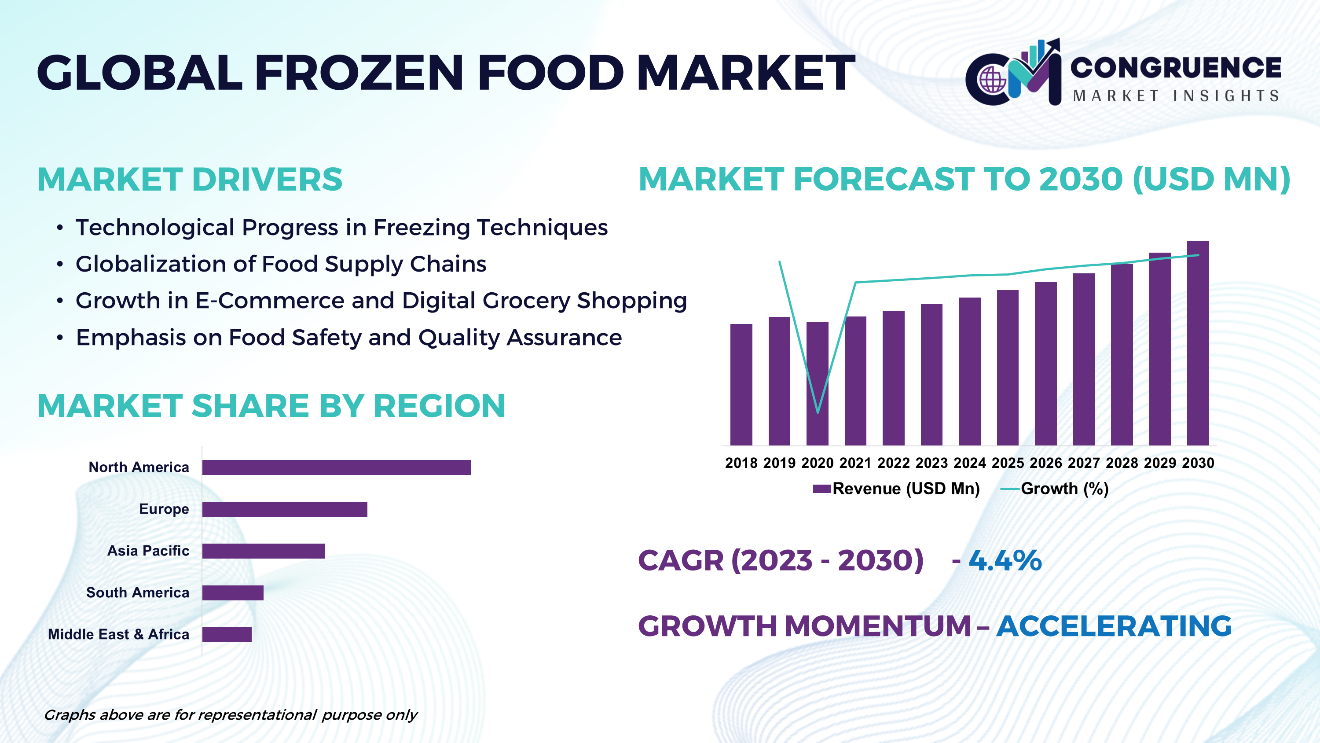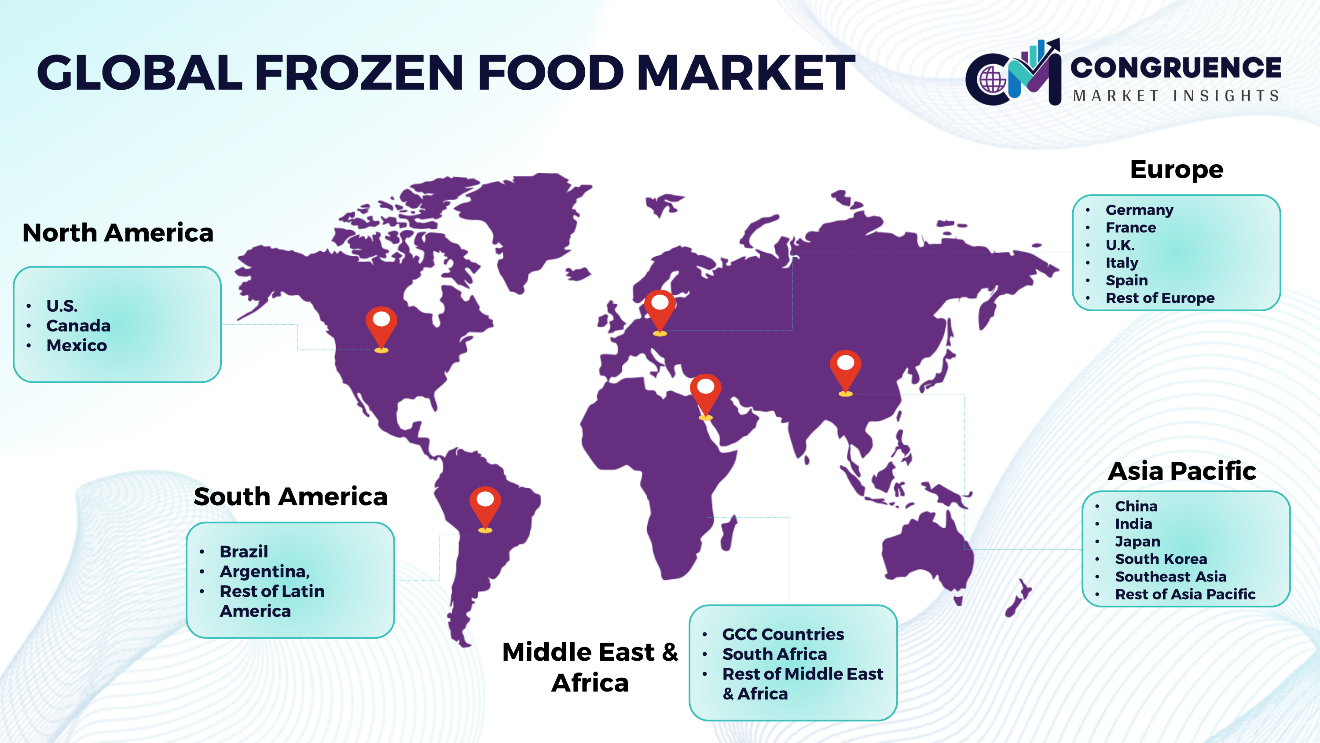Reports
The Global Frozen Foods Market is expected to expand at a CAGR of 4.4% between 2023 and 2030. The frozen food market stands as a fundamental aspect of present-day dietary practices, presenting consumers with a varied selection of convenient and time-efficient choices. The incorporation of technology, particularly in freezing methodologies like Individual Quick Freezing (IQF) and advancements in packaging, has enhanced the quality and longevity of frozen items. This market has experienced consistent growth, aligning with the dynamic lifestyles of consumers worldwide. The integration of innovative freezing approaches ensures the preservation of nutritional value and the enduring appeal of frozen foods. The market landscape encompasses a wide range of frozen fruits, vegetables, ready-to-eat meals, and more, underscoring the industry's dedication to meeting the evolving demands of consumers. The combination of convenience and the preservation of nutritional attributes establishes the frozen food market as a crucial and adaptable element within the contemporary food industry.

Frozen Foods Market Major Driving Forces
Technological Progress in Freezing Techniques: Continual advancements in freezing technologies, exemplified by methods like Individual Quick Freezing (IQF) and enhanced packaging, play a pivotal role in preserving the quality, texture, and nutritional value of frozen foods.
Globalization of Food Supply Chains: The globalized nature of food supply chains grants consumers access to a diverse array of frozen products from different regions, facilitating the availability of out-of-season produce and international culinary options.
Growth in E-Commerce and Digital Grocery Shopping: The expansion of e-commerce and online grocery platforms provides consumers with convenient access to a wide variety of frozen food products, contributing significantly to the market's expansion.
Emphasis on Food Safety and Quality Assurance: Stringent adherence to food safety regulations and the implementation of robust quality assurance measures in frozen food production instill confidence in consumers regarding the safety and quality of these products.
Frozen Foods Market Key Opportunities
Plant-Based and Sustainable Alternatives: With the growing popularity of plant-based diets and heightened environmental awareness, there are chances to expand offerings in plant-based frozen foods and incorporate sustainable practices across the supply chain.
Online Retail and E-commerce Growth: The continued growth of online retail and e-commerce platforms provides an opportunity for frozen foods producers to expand their reach and tap into a broader customer base. Online sales channels allow for easier product accessibility and global market penetration.
Innovations in Packaging Solutions: Opportunities exist for advancements in packaging technologies, encompassing eco-friendly and sustainable packaging options, as well as packaging innovations that improve convenience and product visibility.
Frozen Foods Market Key Trends
· The shift towards healthier frozen food alternatives, featuring products with reduced sodium, fewer preservatives, and the inclusion of superfoods.
· Growing interest in plant-based and vegetarian frozen food selections, propelled by the increasing popularity of flexitarian and plant-centric diets.
· The rise of premium and gourmet frozen meal options designed for consumers seeking high-quality, restaurant-style dining experiences within the comfort of their homes.
· A growing preference for frozen foods with clean labels, emphasizing natural ingredients, transparent sourcing, and minimal processing.
· Increasing emphasis on sustainable packaging choices for frozen foods, incorporating eco-friendly materials and innovative packaging designs aimed at minimizing environmental impact.
· The continual expansion of online and direct-to-consumer sales channels for frozen foods, enabling companies to reach a broader audience and offering consumers convenient digital shopping options.

Market Competition Landscape
The frozen food market boasts intense competition as key players engage in strategic innovations, product diversification, and sustainable practices. Major companies vie for market share through premium and health-focused offerings, driving a dynamic landscape. The competition is marked by continual advancements, mergers, and collaborations, reflecting the industry's commitment to meeting evolving consumer demands and maintaining a competitive edge in the global frozen food market.
Key players in the global frozen foods market implement various organic and inorganic strategies to strengthen and improve their market positioning. Prominent players in the market include:
· General Mills Inc.
· ADM
· Tyson Foods, Inc.
· Universal Frozen Food Inc.
· Conagra Brands, Inc.
· DuPont de Nemours, Inc.
· Nestlé
· McCain Foods
· FINDUS
· Hormel Foods Corporation
· Ajinomoto Co., Inc.
· Dr. Oetker
· Sumeru
|
Report Attribute/Metric |
Details |
|
Base Year |
2022 |
|
Forecast Period |
2023 – 2030 |
|
Historical Data |
2018 to 2022 |
|
Forecast Unit |
Value (US$ Mn) |
|
Key Report Deliverable |
Revenue Forecast, Growth Trends, Market Dynamics, Segmental Overview, Regional and Country-wise Analysis, Competition Landscape |
|
Segments Covered |
· By Product Type (Fruits and Vegetables, Meat and Poultry, Seafood, and Others) · By Technology (Individual Quick Freezing (IQF), Blast Freezing, Plate Freezing, and Others) · By End Use (Residential, Restaurants and Clubs, Cafes and Lounge, and Others) · By Sales Channel (Online Stores, Retail Stores, Specialty Stores, and Others) |
|
Geographies Covered |
North America: U.S., Canada and Mexico Europe: Germany, France, U.K., Italy, Spain, and Rest of Europe Asia Pacific: China, India, Japan, South Korea, Southeast Asia, and Rest of Asia Pacific South America: Brazil, Argentina, and Rest of Latin America Middle East & Africa: GCC Countries, South Africa, and Rest of Middle East & Africa |
|
Key Players Analyzed |
General Mills Inc., ADM, Tyson Foods, Inc., Universal Frozen Food Inc., Conagra Brands, Inc., DuPont de Nemours, Inc., Nestlé, McCain Foods, FINDUS, Hormel Foods Corporation, Ajinomoto Co., Inc., Dr. Oetker, Sumeru |
|
Customization & Pricing |
Available on Request (10% Customization is Free) |
